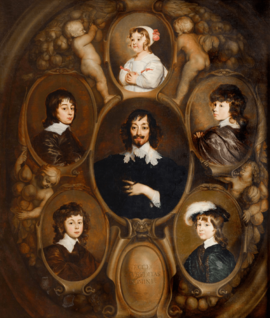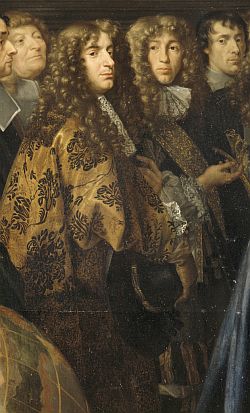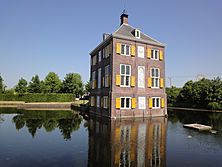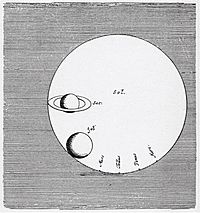Christiaan Huygens facts for kids
Quick facts for kids
Christiaan Huygens
|
|
|---|---|

Christiaan Huygens, 1629-1695, relief by Jean-Jacques Clérion around 1670
|
|
| Born | 14 April 1629 |
| Died | 8 July 1695 (aged 66) |
| Nationality | Dutch |
| Alma mater | University of Leiden University of Angers |
| Known for | Titan Explanation of Saturn's rings Centrifugal force Collision formulae Pendulum clock Huygens–Fresnel principle Wave theory Huygens' engine Birefringence Evolute Huygenian eyepiece 31 equal temperament musical tuning Huygens–Steiner theorem |
| Scientific career | |
| Fields | Physics Mathematics Astronomy Horology |
| Institutions | Royal Society of London French Academy of Sciences |
| Influences | Galileo Galilei René Descartes Frans van Schooten |
| Influenced | Gottfried Wilhelm Leibniz Isaac Newton |
Christiaan Huygens (born April 14, 1629 – died July 8, 1695) was a brilliant Dutch scientist. He was a very important person in the world of mathematics, physics, and astronomy. He also made big steps in understanding probability and how to keep time accurately.
Huygens was one of the top scientists of his time. He studied the rings of Saturn and found its moon, Titan. He also invented the pendulum clock, which was a huge step in timekeeping. He wrote important books about how things move (mechanics) and how light works (optics). He was a big supporter of the idea that light travels in waves. He also did early work on games of chance, which led to the study of probability.
Contents
Biography
Christiaan Huygens was born in The Hague, which is in the Netherlands. His family was rich and powerful. His father, Constantijn Huygens, was a diplomat, a poet, and a musician. He knew many famous thinkers across Europe, like Galileo Galilei and René Descartes.
Christiaan was taught at home until he was 16 years old. He loved to play with small models of machines, like mills. He learned many subjects, including languages, music, history, and mathematics.
When he was 15, a math tutor named Jan Jansz Stampioen gave him challenging books to read. Even famous scientists like Descartes were impressed by his math skills. Another scientist, Marin Mersenne, even called him the "new Archimedes!"
At 16, Christiaan went to Leiden University to study law and mathematics. Later, he continued his studies at the Orange College in Breda. After finishing college, he briefly worked as a diplomat. However, he soon realized he wanted to focus on science.

In 1654, Huygens returned home and spent all his time on research. He published several works that showed his amazing talent in mathematics. He also started to question some of Descartes's ideas about how objects collide. Huygens figured out the correct rules for collisions.
Besides his work on mechanics, Huygens made other big discoveries. In 1655, he was the first to identify Titan as a moon of Saturn. In 1657, he invented the pendulum clock. Then, in 1659, he explained that Saturn's strange shape was due to a ring around it. These discoveries made him famous all over Europe.
In 1666, Huygens moved to Paris. He was invited by King Louis XIV to lead the new French Académie des sciences. He made more discoveries there using the observatory.
Huygens moved back to The Hague in 1681. He inherited his family's summer home, Hofwijck, and lived there. In 1689, he met Isaac Newton in England. They talked about science and later wrote letters to each other.
Christiaan Huygens died in The Hague on July 8, 1695. He was buried in an unmarked grave, just like his father. He never married.
Astronomy Discoveries
Huygens made many important discoveries about space.
Saturn's Rings and Titan
In 1655, Huygens suggested that Saturn was surrounded by a flat, thin ring. He used a powerful telescope that he designed himself. With this telescope, he also found Titan, which was the first moon discovered around Saturn. In the same year, he drew the Orion Nebula. His drawing was the first known one of this nebula. He also found other interstellar nebulae and some double stars.
Mars and Syrtis Major
In 1659, Huygens was the first person to see a surface feature on another planet. He observed Syrtis Major, a large dark area on Mars. By watching how this feature moved, he was able to guess how long a day on Mars was. He was very close! He estimated it to be 24 and a half hours, which is only a few minutes off the actual 24 hours and 37 minutes.
Cosmotheoros
Before he died, Huygens finished a book called Cosmotheoros. In this book, he wondered if there was life on other planets. He thought that life on other planets might be similar to life on Earth.
Huygens believed that liquid water was needed for life. He thought that the dark and bright spots he saw on Mars and Jupiter were signs of water and ice. He also wondered why God would create other planets if they weren't meant to have a greater purpose than just being seen from Earth.
Legacy
Christiaan Huygens is often called the first theoretical physicist. He helped create modern mathematical physics. Many famous scientists, like Isaac Newton, admired his skills. For his work in physics, Huygens is considered one of the greatest scientists of the Scientific Revolution. He also helped set up scientific research groups in Europe, which was important for modern science.
Named after Huygens
Many things are named after Christiaan Huygens to honor his contributions:
Science
- The Huygens probe: A spacecraft that landed on Saturn's moon Titan.
- Asteroid 2801 Huygens: A small rocky body in space.
- A crater on Mars.
- Mons Huygens: A mountain on the Moon.
- Huygens Software: A program used for processing microscope images.
- A type of eyepiece for telescopes that he designed.
- The Huygens–Fresnel principle: A simple model that helps us understand how waves spread.
Other
- The Christiaan Huygens: A ship.
- Huygens Scholarship Programme: Scholarships for students.
- The Huygens-building in Noordwijk, Netherlands: A building at a space business park.
- The Huygens-building at the Radboud University in Nijmegen, Netherlands: A major science building.
Images for kids
See also
 In Spanish: Christiaan Huygens para niños
In Spanish: Christiaan Huygens para niños













